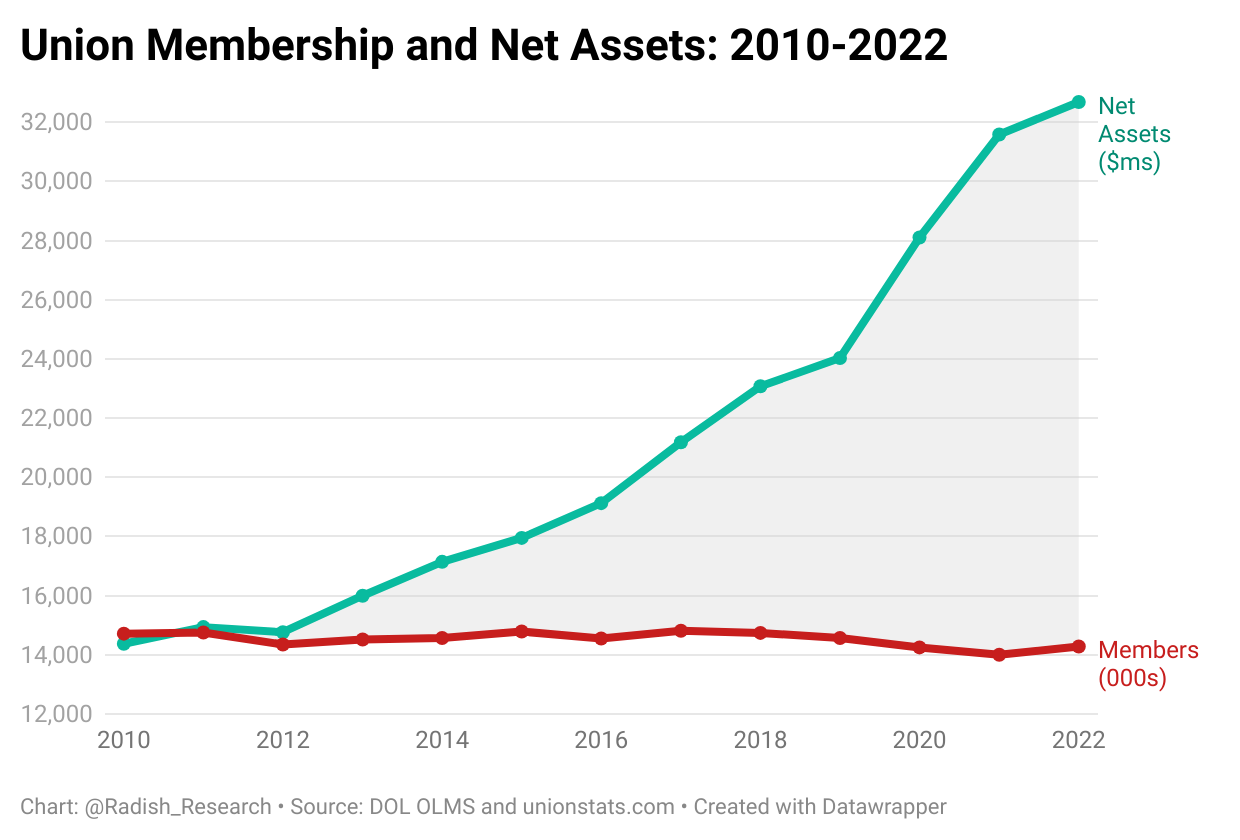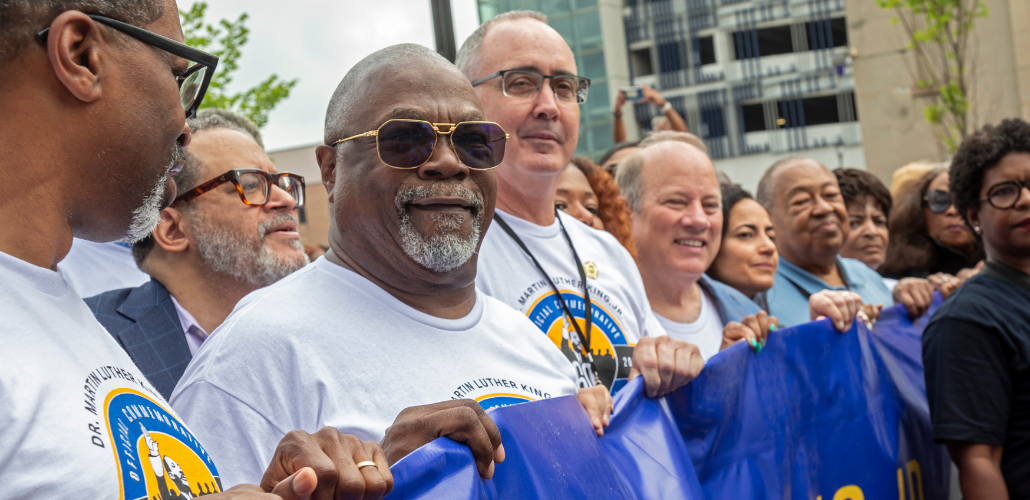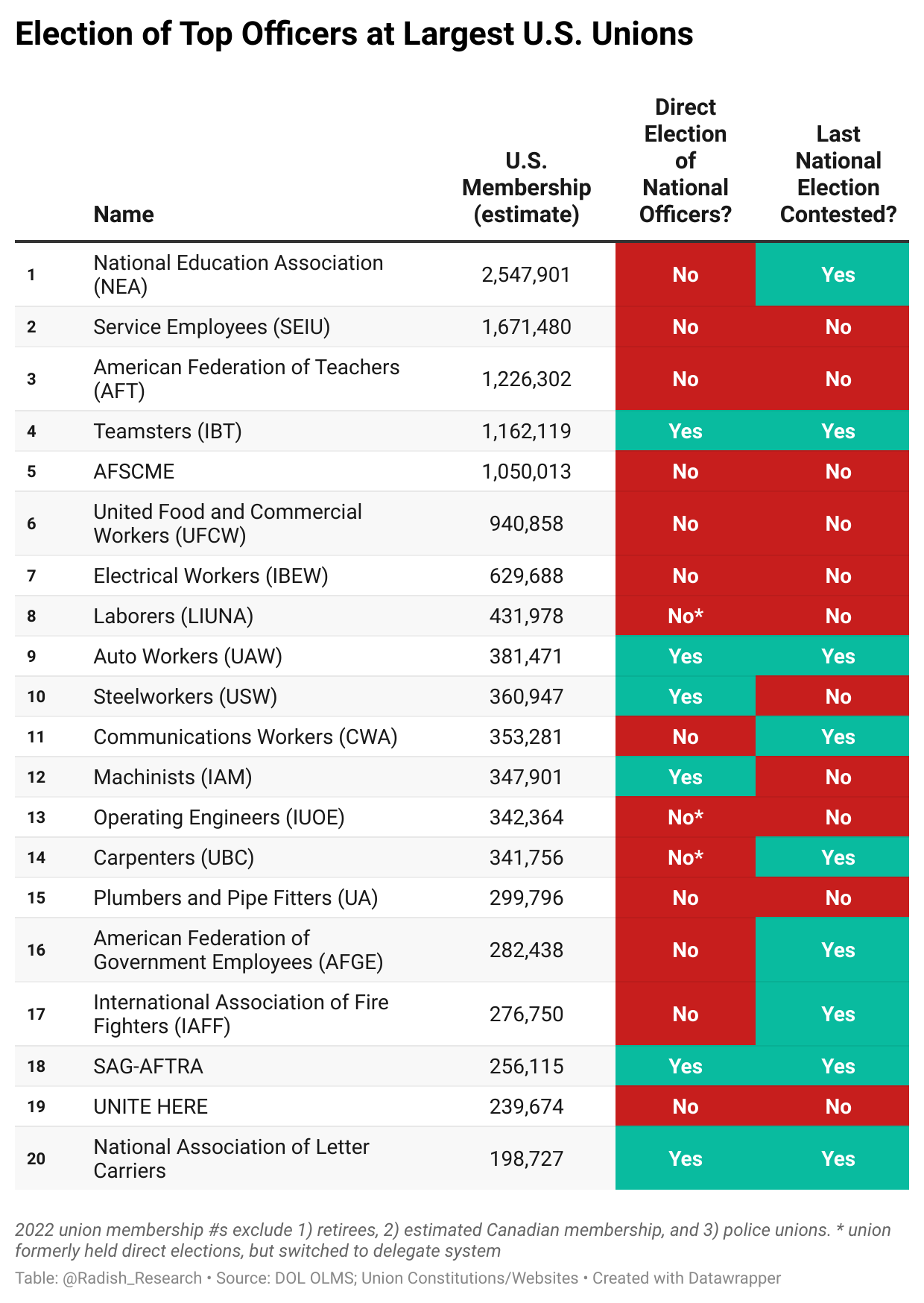The labor movement is rightfully celebrating recent contract victories by the United Auto Workers, Teamsters, SAG-AFTRA and the Writers Guild of America, which together cover nearly 650,000 workers. An essential thread uniting the campaigns is that the top union officers were all directly elected by the members, a basic democratic right denied to many union members in the United States. As other unions seek to learn lessons from these historic contract fights, a key takeaway is that a vibrant democratic process—“one member, one vote”—is crucial to a revitalized labor movement.
A robust democratic process certainly played a major role in the Auto Workers (UAW) contract fight with the Big Three automakers and the Teamsters campaign against UPS. Leading up to their contract expirations, both the UAW and Teamsters had highly competitive and contested elections for their top leadership positions, directly engaging the membership in debates about the union’s negotiation strategy with employers and concessionary contracts, improvements in strike benefits, and the removal of antidemocratic obstacles. For example, at the Teamsters’ convention, delegates removed a constitutional provision that previously allowed union officers to impose a contract even if a majority of members voted against it. Injected with the energy of a contested election, the recent UAW and Teamster conventions were marked by spirited debates about union strategy, engaging members for the upcoming contract fights.
But a review of the constitutions of the 20 largest unions in the United States shows that “one member, one vote” is a right denied to most union members. Of the top 20 unions—representing approximately 13.3 million members and 83 percent of all U.S. union workers—only six have direct elections. Only 20 percent of all union members, or 2.7 million, have the right to directly elect their top officers. In contrast, 80 percent of members, or 10.6 million workers, have no such right.
Apart from the Teamsters and UAW, the only other large unions with a form of direct elections are the Steelworkers, Machinists, SAG-AFTRA, the Letter Carriers (NALC), and the Postal Workers (APWU). Some smaller unions, like the Writers Guild and the Longshore and Warehouse Union (ILWU), also have direct elections.
The Laborers (LIUNA) used to have direct elections as part of a consent decree with the Department of Justice, but the union’s executive board eliminated the practice in 2010. The Operating Engineers and Carpenters also had direct elections, but they moved to a delegate system in the 1960s.
Maybe it’s a fluke of the calendar, but the majority of strikes in 2023 (through October) were led by unions with “one member, one vote” policies, even though they represent a minority of unions. According to the Department of Labor, 448,000 workers have been on strike this year, and approximately 250,000 workers (by my count), or 56 percent of strikers, are affiliated with unions that have direct elections. Perhaps a more democratic union is a more militant union.
‘One Member, One Vote’ vs. the Delegate Convention System
As opposed to direct elections, most unions chose their top officers indirectly, electing delegates to a regularly scheduled convention at the local level through a membership vote. Those elected delegates then nominate and elect the top officers.
While it’s formally democratic, the flaws of the delegate convention system have been widely documented. Rather than promoting worker participation and vigorous democratic debate, the delegate system tends to entrench incumbents who can deploy the union’s vast legal, financial, political, and organizational resources to maintain power and stifle reform challenges. As a result, many unions are effectively run by a semipermanent officer and staff strata insulated from member control and accountability, leading to weakened organizations and a ground ripe for corruption.
Under the delegate convention system, the rise of new leadership at a union is typically triggered by the retirement or death of a labor official rather than a challenger winning a contested election. Union conventions, a huge opportunity to involve the membership in organizing and contract campaigns, instead often resemble a choreographed beauty pageant thrown by the ruling party in a one-party state. With few substantive issues debated and without contested leadership fights, it’s not surprising that labor reporters don’t bother covering most union conventions.
Despite the long-term decline in union membership and urgent debates about the strategic direction of labor, few of the top leaders of large unions even faced a challenger at their last convention, as the table below shows. Of the 14 unions without direct elections, only five had a challenger for the top position. In contrast, of the six large unions with direct elections, four had contested elections.
For over 40 years, union reform movements—led by groups like Labor Notes and the Association for Union Democracy—have challenged this system, arguing for a broad array of democratic reforms to rebuild the labor movement. As Mike Parker and Martha Gruelle argue in their classic book Democracy Is Power:
Some unions do, and many could, operate democratically with a convention system. But for most major U.S. unions, changing to a direct election for international officers would provide an opportunity to rebuild the union on the basis of member control.
Opponents of direct elections argue that contested elections and direct democracy could promote unnecessary conflict and fuel internecine civil wars, weakening a union’s ability to challenge vastly more powerful corporations in contract and organizing fights.
But the UAW’s recent history tells a different story. While the strike at the Big Three automakers has been hailed by many as one of the most consequential strikes in decades, it is also the direct result of a highly democratic process. Since 2021, the UAW has held multiple elections and membership votes, including approving a referendum for direct elections of officers; electing delegates to the convention; holding two general membership elections for top officers (including the runoff); approving a strike vote at the Big Three; and, most recently, holding ratification votes for the auto contracts. While many of these votes have been contentious and close-fought, the end result has been a more engaged membership and a revitalized union.
Democracy, Finance Unionism, and Reform Caucuses
One impact of labor’s flawed governance system is the perpetuation of “finance unionism,” in which union leadership focuses on the continual accumulation of financial assets rather than using those resources for mass organizing and militant strike activity. According to Department of Labor data, since 2010, organized labor has lost nearly half a million members—yet labor’s net assets (assets minus debt) have increased from $14 billion to $33 billion in 2022, a 127 percent increase. A union leadership class insulated from real democratic control helps make finance unionism possible.

However, as the UAW demonstrates, when a union moves to direct elections of leadership, it is more apt to use its financial assets for strikes and growth. For example, rather than continuing to invest the UAW’s massive strike fund in Wall Street hedge funds and private equity, the directly elected officers used those assets to fund a militant and successful strike, likely costing the union close to $100 million in strike benefits. And on the heels of the contract victory, the union has announced an ambitious campaign goal of organizing 150,000 nonunion autoworkers at 13 companies.
The lack of direct elections of officers also makes the task of internal union caucuses pushing for democratic reform—i.e., internal opposition parties like the Teamsters for a Democratic Union or the UAW’s Unite All Workers for Democracy—much more difficult to achieve.
This was on vivid display this year at the United Food and Commercial Workers convention. Led by one of the largest UFCW locals, the Essential Workers for Democracy reform caucus proposed a raft of common sense resolutions, including requiring only a majority vote to authorize strikes (scrapping the two-thirds requirement), strike benefits beginning on day one, capping salaries for international local staff and officers to $250,000, and devoting at least 20 percent of the union’s budget to organizing new workers.
Yet these basic reforms were overwhelmingly defeated at the convention, with only a handful of locals supporting the resolutions. If the general membership of the UFCW had direct elections, these resolutions would have likely received widespread support (just as UAW and Teamster members supported similar measures at their conventions). Essential Workers for Democracy is building toward the 2028 UFCW convention for another crack at direct elections, but the labor movement needs these reforms now.
Reform from the Right or the Left?
No large union in the past 40 years has voluntarily adopted “one member, one vote.” While reform caucuses at the Teamsters and UAW had pushed for direct elections for years, it did not become a reality until the Department of Justice (DoJ) filed criminal complaints at both unions and imposed democratic reforms as a remedy to rampant corruption and criminality facilitated by the delegate election system.
In the case of the Teamsters, the union reached a settlement with George W. Bush’s administration to implement direct elections after the filing of a wide-ranging racketeering lawsuit by the DoJ (and lobbying by TDU). The UAW reached a settlement with the Donald Trump DoJ to hold a referendum on direct elections (64 percent of UAW members voted yes) after the filing of a broad criminal complaint.
Ironically, anti-union Republican administrations were an important component of democratic reform at the UAW and Teamsters. But the history of labor reform is filled with strange bedfellows.
For example, in 1959, Congress passed the Labor Management Reporting and Disclosure Act (LMRDA). Broadly seen as an attack on unions by business groups seeking to roll back new organizing, the law tightened restrictions on secondary boycotts, restricted pickets for union recognition, and banned Communists from holding union office. But the law also provided crucial reforms, including a bill of rights for union members, secret ballot elections for union officers, the right of members to see their union contracts, and the public disclosure of union annual financial reports.
Even the Trump administration’s Department of Labor proposed meaningful reforms, including requiring unions to disclose their totals spent on organizing versus collective bargaining (very difficult data for members to obtain from most unions), the size of strike funds, and whether union officers are receiving multiple salaries from different labor bodies (“double dipping”). In addition, the Department of Labor proposed requiring more public unions to file financial reports, as many are currently exempt from the LMRDA. These reforms were widely opposed by organized labor and were shelved after Joe Biden assumed power.
Unfortunately, if labor continues its long resistance to democratic initiatives like direct elections and greater transparency, these reforms may be imposed by hostile political forces like the George H. W. Bush administration’s takeover of the Teamsters in 1989, or the 1959 LMRDA reforms that were paired with a rollback of important labor rights like secondary boycotts. No one in the labor movement should desire a scenario where the state steps in to control a free and autonomous labor movement. But with freedom comes the responsibility to engage in democratic self-reform.
Such democratic reform—as the UAW and Teamster contract fights illustrate—strengthens the power of the labor movement by mobilizing the membership in big fights and developing consensus on labor strategies through open debate. While “one member, one vote” threatens the power of the semipermanent strata of labor leaders and staff, sometimes the greatest act of leadership is to voluntarily devolve that power.
Rather than fighting democratic reform initiatives, it is high time for organized labor to let the members decide by holding referenda on direct elections for officers. While the delegate convention system can be democratic, it has too often been the ally of corruption and passivity. If this system is worth defending, then it should be put up to a vote by the membership. Ultimately, as Labor Notes pointed out 25 years ago, “Union democracy—defined as rank-and-file power—is the essential ingredient for restoring the power of the labor movement.”
Chris Bohner is a union researcher and activist. This article first appeared in Jacobin.










